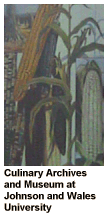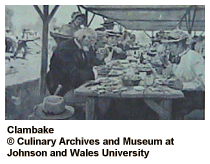B.C. 75,000-45,000
Scholars debate when Asians first crossed the Bering land bridge and entered North America. The first human hunter-gathers who arrived in North America lived simultaneously with Pleistocene animals that included mammoths, mastodons, and saber-toothed cats. These first Americans did not have domesticated animals or livestock, except the dog. [1: 16]
B.C. 4000.
A wide variety of plants and animals native to the Americas were domesticated in North, Central, and South America. Among the more prominent were: artichoke, avocado, kidney beans, lima beans, blackberry, cacao (chocolate), cassava, chili pepper, cranberry, guava, maize (corn), papaya, peanut, pecan, pineapple, potato, pumpkin, raspberry, sunflower, tomato, and the turkey. [1: 17]
A.D. 1492
[On] this island, there are many spices and great mines of gold and of other metals. [The Indians] endure cold with the help of meats which they eat with many and extremely hot spices. I believe that I have found rhubarb and cinnamon, and I shall find a thousand other things of value.
Christopher Columbus
First Voyage, 1492 [1: 18]
A.D. 1495
And though we have enough biscuit, as well as [wheat], for some while, yet it is necessary that some reasonable amount should also be sent, for the voyage is long and provision cannot be made every day, and likewise some salt meat, I mean bacon, and other salt flesh, which would be better than that which we have brought on this voyage. As to livestock, sheep and lambs above all, more females than males, and some calves and young heifers are necessary, so that they should come.
Christopher Columbus.
Second Voyage. 1495 [1: 19]
A.D. 1513
Ponce de León joined Columbus on his second voyage to the Caribbean and demonstrated his ability as an administrator in Haiti. He was appointed local Governor and raised cattle and horses. He landed in Florida in 1513 and claimed the land for the king of Spain. [1: 20]
 The word maize comes from the Taino language? Taino was the dialect spoken by the Arawaks, the Caribbean people who first greeted Columbus in 1492. The term maize became a loan word in Spanish and subsequently entered other European languages. The word corne, spelled today as corn, comes from the old English dialect term for grain and specifically is used to designate wheat. When the English-speaking Pilgrims encountered maize for the first time, they called it Indian Corne because they did not know or recognize the plant, but they knew it was a grain. [1: 8]
The word maize comes from the Taino language? Taino was the dialect spoken by the Arawaks, the Caribbean people who first greeted Columbus in 1492. The term maize became a loan word in Spanish and subsequently entered other European languages. The word corne, spelled today as corn, comes from the old English dialect term for grain and specifically is used to designate wheat. When the English-speaking Pilgrims encountered maize for the first time, they called it Indian Corne because they did not know or recognize the plant, but they knew it was a grain. [1: 8]
Succotash was the Narraganset word meaning "fragments?" Succotash was a classic Native American and Colonial period one-dish meal that consisted of corn and beans, sometimes ground sunflower seeds or pine nuts. Succotash usually was sweetened with maple syrup in northern colonies, and with bear fat in the south. [1: 9]
Pemmican was a Native American food made from buffalo meat or venison, melted fat, berries, and bone marrow, dried and compressed into small cakes? The word, pemmican, originated from the Cree language term, pemikan, and first appeared in English in 1791. [1: 10]
Seventeenth century recipes for Boston brown bread were adapted by the Colonists from local Native Americans, who prepared corn bread by steaming? Today, Boston brown bread is made from a mixture of flours, including corn, and is steamed, not baked. [1: 11]
Corn bread sticks sometimes were so hard when first baked, that if thrown, the intended victim "dodged" to keep from getting hit? This is how the corn dodger got its name. Did you know that the corn dog was created at the Texas State Fair, Dallas in 1942? [1: 12]
Native Americans boiled their foods by heating rocks and placing them into water-filled baskets? In the American southwest Indian basketry technology was so advanced that many baskets were water tight. In the American southeast Indians had mastered pottery and developed technology for making fired clay pots. [1: 13]
 Clambakes were invented by Native Americans? Fires were built in stone-lined pits. When the fire died down, the pit was filled with layers of seaweed, clams, crabs, lobsters, and corn, then covered so the foods could steam. [1: 14]
Clambakes were invented by Native Americans? Fires were built in stone-lined pits. When the fire died down, the pit was filled with layers of seaweed, clams, crabs, lobsters, and corn, then covered so the foods could steam. [1: 14]
Cranberries were called sassamanesh by the Indians of New England? Cranberries were eaten both raw and cooked. [1: 15]
A.D. 1518
Forks first mentioned as a European eating utensil. American colonists were accustomed to using spoons to hold down food as it was cut, then putting down the knife and shifting the spoon to the right hand, then transferring food to the mouth by spoon. Forks were two pronged until the end of the eighteenth century, when three and four pronged forks became the standard. Americans were late in the adoption of the fork. Americans mostly used knives until after the Civil War. [1: 21]
A.D. 1519
Early next morning a few Indians approached us in a canoe bringing several chickens and enough maize to make a meal for a few men and bidding us accept these and depart from their land...
Hernando Cortéz. 1519. [1: 22]
Hunter-gathers entered North America before domestication of the chicken, and therefore could not have brought them to the New World. The above passage reveals that chickens were in the New World before the arrival of Columbus. The question remains: who introduced them? Did African, Chinese, or Indian explorers reach the New World before Columbus?
A.D. 1539
About forty leagues from Quiguate stood Coligoa, at the foot of a mountain, in the vale of a river of medium size... The soil [here] was rich, yielding maize in such profusion that the old was thrown out of store to make room for the new grain. Beans and pumpkins were likewise in great plenty: both were larger and better than those of Spain: the pumpkins, when roasted, have nearly the taste of chestnuts.
Fidalgo de Elvas. 1557
Member of the De Soto Expedition [1: 23]
A.D. 1540
In five days [we] reached a village which was on a rock called Acuco [Acoma Pueblo], having a population of about 200 men . . . on the top they had room to sow and store a large amount of corn, and cisterns to collect snow and water. . . They made a present of a large number of turkey cocks with very big wattles, much bread, tanned deer skins, pine nuts [piñon], flour [corn meal], and corn.
Pedro de Castañada, 1596
Member of the Coronado Expedition [1: 24]
A.D. 1565
Spanish colony of St. Augustine was founded in Florida by Pedro Menéndez de Avilés. [1: 25]